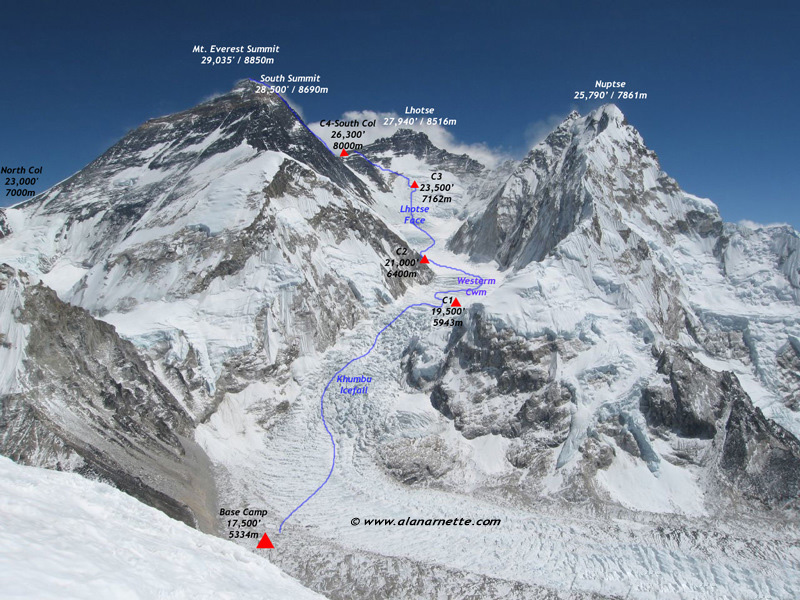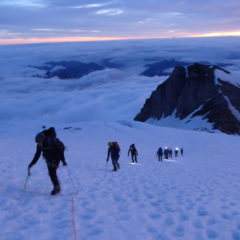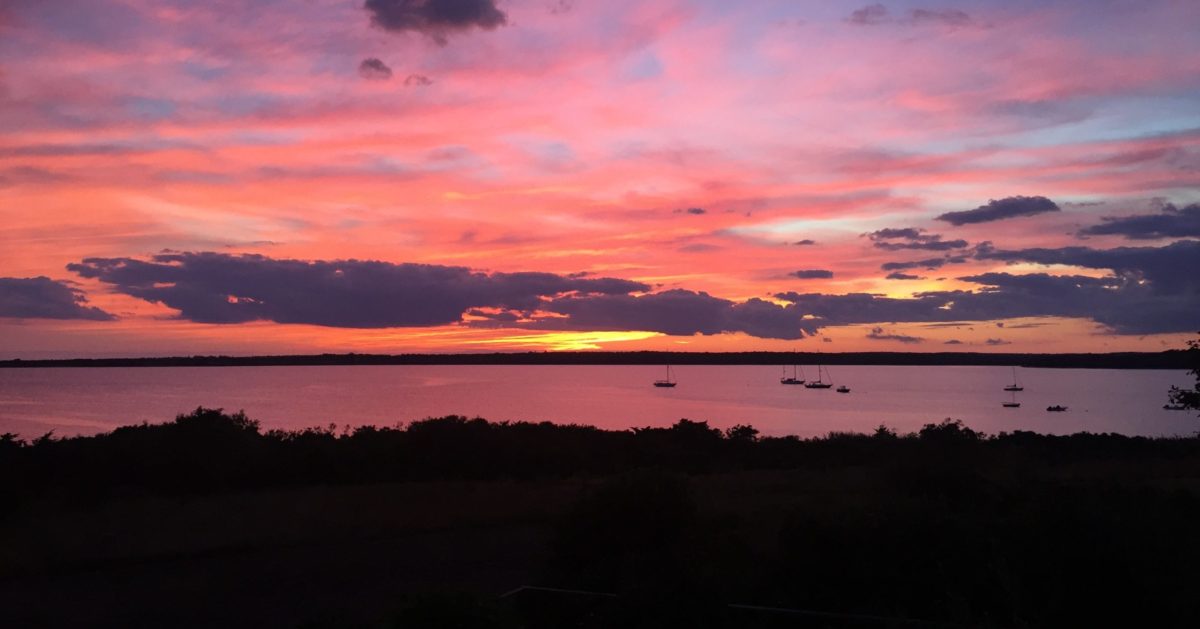Everest Base Camp is a mini tent city of approximately 700 people, (around 300 climbers, 400 support), built on the Khumbu glacier at the base of the (in)famous Khumbu icefall. The tents are strung out along the glacier, with each expedition having its own specific area. It takes almost an hour to walk from the first cluster of tents at the bottom of camp to the last cluster of tents at the top. Our cluster is close to the top. Here is a photo taken from a ridge above base camp. If you look closely, you can see all the tents strung out along the glacier.

The physical location is spectacular: at the end of a deep valley surrounded by towering peaks; Pumori on one side, Everest, Lhotse, and Nuptse on the other. You can’t see the upper part of Everest from basecamp, as it is hidden behind the so-called Western Shoulder, but if you hike up a ways behind camp the full mountain appears. What you absolutely can see from basecamp is the lower half of the Khumbu icefall; a jagged mass of ice blocks and crevasses, caused by the glacier being forced steeply downward between the lower flanks of Everest and Nuptse.
If you are a climber, or someone who likes reading about Everest, the Khumbu icefall has mythic stature. All climbers must pass through it on their way to the upper reaches of the mountain. There are a number of risks associated with this, which I will elaborate on in subsequent posts. The icefall is also an intensely powerful and beautiful sight. I wake up every day, look up at it, and can’t believe I am here.
Here is a photo of the lower icefall, with the Western Shoulder rising above it on the left. My tent is in the foreground.

As you can see, the tents are set up on rocky rubble which is the top layer of the glacier. Under the rubble is solid ice, and you hear occasional creaks and groans as the glacier shifts. Over the course of our two month climbing season, tents will need to be relocated occasionally as the glacier continues to move.
The other thing you hear frequently at base camp is avalanches. Some are relatively small and far away, and some are large and relatively close. When you hear a big one, you stop what you are doing and look up. The sight is simultaneously awe inspiring and unnerving. In 2014, an avalanche off the Western Shoulder tragically killed 14 Sherpas in the icefall. In 2015, an avalanche off the side of Pumori, caused by a major earthquake, wiped out a portion of base camp, killing 18 people. These risks are never far from your mind, especially as you lie in your sleeping bag at night and hear avalanches thundering down the surrounding peaks.
We have been here for over a week, getting our bodies used to the altitude before we ascend higher on the mountain. Part of this involves acclimatization hikes up the flanks of mountains behind camp. We have also been going into the initial portion of the icefall to practice the technical skills we will need above basecamp. These include ice climbing, pulling ourselves up vertical ropes using a handheld device called a jumar, rapelling, and crossing crevasses on horizontal ladders with our crampons and packs on.
Each day in base camp has a familiar rhythm. You wake up in your tent, reluctant to leave your sleeping bag’s warmth given that outside temperatures are in the low teens. Things warm up as the sun makes it above the surrounding peaks. It is pleasant sitting outside in the sun, and really pleasant to lie in your tent mid day when the sun is hitting it. But when the clouds roll in, as they usually do in the afternoon, temperatures drop quickly and it is time to pull on your down parka, down pants, and warm boots. Meals are served in our comfortable dining tent. The food, prepared by our Nepali expedition cook, is amazingly good, especially for 17,500 feet.
One of my favorite moments each day is when I leave the dining tent after dinner to head back to my tent. I climb up on some rocks, brush my teeth, and look around. On a clear night, the stars are incredible, and I can see white peaks outlined against the night sky. Some nights, I see a trail of headlamps picking their way through the icefall: teams of Sherpas climbing through the night to move loads to higher camps. Then I head to my tent and zip myself into my sleeping bag, making sure that at least one water bottle is zipped in with me so it doesn’t freeze overnight.
While everyone is eager to begin moving up the mountain, we know the importance of putting in time at basecamp. Above all, climbing Everest is about methodically preparing one’s body to survive and perform at progressively extreme altitudes. It is also about maintaining patience and inner calm over an extended period of time. It typically takes six to seven weeks between the time an expedition arrives at base camp and the time people are able to attempt the summit.
In climbing the mountain, we will follow the approach used by virtually all expeditions; ascending in stages called “rotations “. Here is a map of our route, showing the location of base camp and the four additional camps we will make higher on the mountain.

On our first rotation, which will start in around five days, we will climb up though the icefall to Camp 1, spend a couple of nights there acclimating, climb to Camp 2, spend a couple of night there, then descend back down through the icefall to base camp for some welcome thicker air and rest. On our second rotation, we will climb back up to Camps 1 and 2, then to Camp 3, before again returning all the way down to base camp. We will rest and wait at base camp until a weather window emerges that offers an opportunity to approach the summit. When we get that window, which will likely happen around the third or fourth week of May, we will climb back through the icefall and spend nights at Camps 2, 3, and 4, before launching a final climb to the summit. More on all of this later, but this gives you a rough idea of the plan.
Some notes on the above route photo: 1) It may be a helpful reference in the coming weeks as I describe our experiences at various stages on the mountain, 2) Many thanks to Alan Annette for letting me use it. In addition to having summited Everest and numerous other peaks, Alan is the preeminent chronicler of Everest climbing seasons. For those of you who over the coming weeks want to do a major deep dive on the Everest action, go to Alan’s website and click on “Everest 2021”, 3) Alan’s route photo appears to have been be taken from Camp 1 on Pumori , the destination of several of our acclimatization hikes. These are the views we have been looking at as we get our bodies ready to move up the mountain.
I am feeling good about things so far. Many people upon arriving at base camp experience altitude-related symptoms such as headache, loss of appetite, nausea, and difficulty sleeping. While this has been true for some of our team members, I have pretty much avoided it. My time will certainly come as we get higher on the mountain, but for now I am pleased.
At the same time, this is already a very different experience than our trek from Lukla to here. On our acclimatization hikes, while I am holding my own, every step is an effort. I am pushing my physical limits, and the experience is just plain hard work rather than something I am enjoying. During our technical skills sessions in the icefall, while I am doing fine, I am not yet executing certain basic moves as smoothly as I would like. While I have plenty of time to get in the groove, I wonder what things will be like when I am at higher altitude, in freezing cold conditions, when it really matters.
This is all an inherent part of climbing big mountains, especially mountains like Everest. I knew what I was getting into, and just hope that things continue to break my way as we get higher on the mountain.
As mentioned, we leave on our first rotation in five days. We then lose the luxury of internet access, so my posts will have to wait until I get back down to base camp. I will try to post once more in the next few days before we head into the icefall for real.
Ever upward!


You’ll be in all of our continuous thoughts! Be safe, and use that great judgment of yours!
Your descriptions are so marvelous, I feel like I’m right there with you (easily said as I bask in the late afternoon sun in San Francisco, glass of wine in hand…)
Thinking of you. Here is where I go in my reach to join you:
When despair for the world grows in me
and I wake in the night at the least sound
in fear of what my life and my children’s lives may be,
I go and lie down where the wood drake
rests in his beauty on the water, and the great heron feeds.
I come into the peace of wild things
who do not tax their lives with forethought
of grief. I come into the presence of still water.
And I feel above me the day-blind stars
waiting with their light. For a time
I rest in the grace of the world, and am free.
Wendell Berry
Tom, I am thinking of you everyday. Thank you for sharing your journey. I have enjoyed your incredible writing and have learned so much about climbing Mt. Everest. I am in awe of your accomplishments. Stay safe.
Amazing description of it all. Stay safe
One comment and one request.
Comment: please take everything you don’t absolutely need out of your backpack because you are now carrying all your followers and we want to see Everest
Request: you natural modestly precludes you from including a snap of Tom French. Please do. I for one would love to see you in situ.
Tom, like some of your other followers, Anne & I are vicariously enjoying your exploits from the sunny & warm Bay Area (El Cerrito, East Bay). One foot in front of the other…with awareness.
Tom, go with God…you are as ready as any human being has ever been. We are all cheering for you!
Thank you Tom,
I am enjoying your blog very much. I think Fred got to about 19,500 feet on Pumori in 1965. He never intended to summit Everest and was just pleased by experiencing getting that high.
Susan
Good luck Tom! It’s so exciting that you are finally doing this. The detail you are providing is fascinating and gives us a chance to understand what this experience is really like. I look forward to the next post.
Your journey AND blog are friggin amazing! Can’t wait to hear about this live, but in the meantime, it’s the best series I’m tuned in to!
Thanks for taking us along to the top of the world. Your humility in nature will certainly help you get there!
Tom, hoping things continue to break your way and that in the moments they don’t, your training carries you through. Thank you for sharing with all of us. I am (perhaps naively?) struck by the patience required to attempt this feat. I have read before about this but it is coming alive as I read your posts.
Thanks for this informative latest update! Thinking of you…
Best email I get in my morning inbox Frenchy!!! I too had no clue how much prep time goes into this, but it’s clear as to the importance of it all………it reminds me of all of our B-team TCC paddle! 😀. Thanks for keeping us along with you, and I look forward to hearing about your trip further up.
Thanks for continuing to share your journey, so amazing!
Yes, yes let’s see a picture of you French!
Continued good fortune to you up top!
Namaste! 🙏✌️
Tom – your journey has inspired me to learn about this incredible endeavor. The more I read, the more in awe I am of what you are accomplishing. For the record, I was able to push my golf pushcart up the hill on Primrose 8 yesterday in one go with no oxygen, so I feel like we are climbing brothers…
WOW! It is humbling to think of your daily routine and experience.. both the physical and the spiritual… Holding you in The Light, till you are back down and in Jill’s arms. AND, Holding her and all the family as well, so they too come thru this brilliantly. All the very best. Please take care!
Only two word response from me, “Captivated & Speechless.” Godspeed!!!
As ever was, your narrative inspires…you have done the hard physical training to prepare your body, now work on the deep focus that you need for those technical tasks…you have the necessary mental toughness to persevere, and we are all with you…vaya con Dios…
-ghc-
Your writing really does make us feel like we’re there. Thanks for sharing the experience with us!
Great to hear your body and mind are acclimating. I was particularly struck in this post by your self-awareness of the physical and mental work involved. Your details about the preparation are quite amazing.
Still in awe of your writing and your insight into the whole Everest trip. Just learned that my Nextdoor neighbor, Eben Reckord climbed Everest with Ben in 2010 and 2011. He admits to stopping short of the summit in 2011. He says Ben will remember him. God speed Tom!
If anyone can do it, you can Mr. TF! I have witnessed your mental strength and stamina on the paddle and tennis courts and have read about your prowess on the Nordic snows at the Green Machine and beyond. Yes, no one is in a hurry! Patience and the weather are a virtue. I won’t soon forget a documentary I watched on summiting Everest with a line of climbers and Sherpa’s ‘too long’ on summit night/day. Please use every bone in your body and every synapse in your brain to avoid that scenario. Godspeed my friend! Can’t wait for your next post!
-HTR
Dear Tom,
Thank you for sharing the details with us. Every aspect of your journey is fascinating. Looking forward to hearing more about your teammates and other teams on the mountain this season. Also, would love a sketch of what a typical day’s fluid and food intake looks like.
Stay well!
Amy
Practice hopefully makes perfect. How fortunate to have no Stokes breathing or headaches. Hope that lasts for you! Take it one step at a time, find that calm and inner peace. Namaste!
gosh, Tom – I am running out of words to describe how excited I am for you as this endeavor continues! Thanks for the map from Alan Arnette; and I have now spent hours reading through his posts (https://www.alanarnette.com/blog/2021/02/28/everest-2021-team-locations-and-headlines/) for anyone looking for his website!
It is a fascinating journey you are on and so thrilling to be able to follow along!
Hi Tom,
What an amazing adventure brought to life by your wonderful storytelling. Between the Facebook posts and this blog, I almost feel like I am there with you. Enjoy the dream!
Stephanie